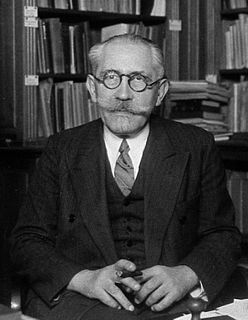Medical physics is a profession which deals with the application of the concepts and methods of physics to the prevention, diagnosis and treatment of human diseases with a specific goal of improving human health and well-being. Since 2008, medical physics has been included as a health profession according to International Standard Classification of Occupation of the International Labour Organization.

Paul Langevin was a French physicist who developed Langevin dynamics and the Langevin equation. He was one of the founders of the Comité de vigilance des intellectuels antifascistes, an anti-fascist organization created after the 6 February 1934 far right riots. Being a public opponent of fascism in the 1930s resulted in his arrest and being held under house arrest by the Vichy government for most of World War II. Langevin was also president of the Human Rights League (LDH) from 1944 to 1946, having recently joined the French Communist Party.
Frans Josef Thomas Wackers is a medical doctor and research scientist in the field of nuclear cardiology.
Noemie Benczer Koller is a nuclear physicist. She was the first tenured female professor of Rutgers College.

Cardiac imaging refers to non-invasive imaging of the heart using ultrasound, magnetic resonance imaging (MRI), computed tomography (CT), or nuclear medicine (NM) imaging with PET or SPECT. These cardiac techniques are otherwise referred to as echocardiography, Cardiac MRI, Cardiac CT, Cardiac PET and Cardiac SPECT including myocardial perfusion imaging.

Fay Ajzenberg-Selove was an American nuclear physicist. She was known for her experimental work in nuclear spectroscopy of light elements, and for her annual reviews of the energy levels of light atomic nuclei. She was a recipient of the 2007 National Medal of Science.
Lydia E. Kavraki is a Greek-American computer scientist, the Noah Harding Professor of Computer Science, a professor of bioengineering, electrical and computer engineering, and mechanical engineering at Rice University. She is also the director of the Ken Kennedy Institute at Rice University. She is known for her work on robotics/AI and bioinformatics/computational biology and in particular for the probabilistic roadmap method for robot motion planning and biomolecular configuration analysis.

Jill Trewhella FAAAS FLANL Dist FRSN is a biophysicist who has worked in both Australia and the United States.
Ola (Olakunle) Akinboboye is a Nigerian-American nuclear cardiologist.
Marcela Bilek is a Professor of Applied Physics and Surface Engineering at the University of Sydney, Australia. Her research interests focus on the use of plasma related methods to synthesise thin film materials and modify surfaces and interfaces. She was named Fellow of the American Physical Society in 2012 and Fellow of the Institute of Electrical and Electronics Engineers (IEEE) in 2015 for contributions to the science and application of plasma processes for materials modification and synthesis. Among her many awards are the Malcolm-McIntosh Prize for Physical Scientist of the Year in 2002 and the Pawsey Medal awarded by the Australian Academy of Science in 2004.
Katie Jane Grande-Allen is an American bioengineer currently the Isabel C. Cameron Professor at Rice University. She is currently chair of the Department of Bioengineering at Rice University. Her research focuses on an engineering approach to heart disease.

Roderic Ivan Pettigrew is an American physicist, engineer, and physician who is CEO of EnHealth and Executive Dean for EnMed at Texas A&M University. From 2002-November 2017, he was the founding director of the National Institute of Biomedical Imaging and Bioengineering (NIBIB) at the National Institutes of Health (NIH). He is a pioneer and world expert in cardiovascular magnetic resonance imaging (MRI).
Christy K. Holland is an American scientist and professor of internal medicine and biomedical engineering at the University of Cincinnati. After a B.A. with majors in physics and music at Wellesley College, she obtained her Ph.D.in engineering and applied science from Yale University. Holland is editor-in-chief of Ultrasound in Medicine and Biology. Holland's articles in peer-reviewed scientific journals have been cited over 6300 times, giving her an h-index of 46.
Suzanne Knoebel was an American internationally known cardiologist, a member of the Indiana University School of Medicine faculty, a visiting fellow at the National Institutes of Health, and the first female president of the American College of Cardiology (1982–83). She was especially known for her interests in academic research, education, and patient care.

Joan Laverne Mitchell was an American computer scientist, data compression pioneer, and inventor who, as a researcher at IBM, co-invented the JPEG digital image format.
Alison Lesley Marsden is an American bioengineer. She is an associate professor of pediatric cardiology, bioengineering, and mechanical engineering at Stanford University.
Gloria Lubkin was an American science journalist and editor for the magazine Physics Today, of which she was the editor-in-chief from 1985 to 1994. She also cofounded the Theoretical Physics Institute at the University of Minnesota and was a fellow of both the American Physical Society and the American Association for the Advancement of Science.
Donna Lee Hudson is an American biomedical engineer known for her research on expert systems for medical diagnosis and on the application of chaos theory to heart rhythms. She is a professor emerita at the University of California, San Francisco.





